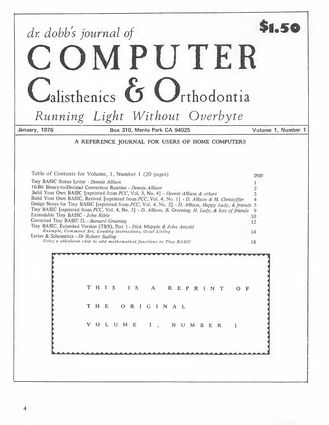
[author : Dennis Allison] #BASIC
Extract : « The magic of a good language is the ease with which a particular idea may be expressed. The assembly language of most microcomputers is very complex, very powerful, and very hard to learn. The Tiny BASIC project at PCC represents our attempt to give the hobbyist a more human-oriented language or notation with which to encode his programs. This is done at some cost in space and/or time. As memory still is relatively expensive, we have chosen to trade features for space (and time for space) where we could.
Our own implementation of Tiny BASIC has been very slow. I have provided technical direction only on a sporadic basis. The real work has been done by a number of volunteers; Bernard Greening has left the project. As might be guessed. Tiny BASIC is a tiny part of what we do regularly. (And volunteer labor is not the way to run a software project with any kind of deadline!)
While we've been slow, several others have really been fast. In this issue we publish a version of Tiny BASIC done by Dick Whipple and John Arnold in Tyler, Texas. (And other versions can't be far behind.) [...] »
[author : Dennis Allison] #Encoding
[author : Dennis Allison & others] #BASIC
Extract : « (reprinted from People’s Computer Company Vol. 3, No.4)
A DO IT YOURSELF KIT FOR BASIC??
Yes, available from PCC with this newspaper and a lot of your time. This is the beginning of a series of articles in which we will work our way through the design and implementation of a reasonable BASIC system for your brand X computer. We'll be working on computers based on the INTEL 8008 and 8080 microprocessors. But it doesn’t make much difference — if your machine is the ZORT 9901 or ACME X you can still build a BASIC for it. But remember, it’s a hard job and will take lots of time particularly if you haven’t done it before. A good BASIC system could easily take one man six months! We'd like everyone interested to participate in the design. While we could do it all ourselves, (we have done it before) your ideas may be better than ours. Maybe we can save you, or you can save us, a lot of work or problems. Write us and we'll publish your letter and comments. [...] »
[author : D. Allison & M. Christoffer] #BASIC
Extract : « (reprinted from People’s Computer Company Vol. 4, No. 1)
WHAT IS TINY BASIC???
TINY BASIC is a very simplified form of BASIC which can be
implemented easily on a microcomputer. Some of its features are:
Integer arithmetic 16 bits only
26 variables (A, B,. . ., Z)
Seven BASIC statements INPUT PRINT LET GOTO IF GOSUB RETURN
Strings only in PRINT statements
Only 256 line programs (if you’ve got that much memory)
Only a few functions including RND
It’s not really BASIC but it looks and acts a lot like it. I’ll be good
to play with on your ALTAIR or whatever; better, you can change
it to match your requirements and needs. [...]
»
[author : D. Allison, Happy Lady, & friends] #BASIC #Listing #IL
Extract : « (reprinted from People’s Computer Company Vol. 4, No. 2)
SOME MOTIVATIONS
A lot of people have just gotten into having their own computer. Often they don't know too much about software and particularly systems software, but would like to be able to program in something other than machine language. The TINY BASIC project is aimed at you if you are one of these people. Our goals are very limited to provide a minimal BASIC-like language for writing simple programs. Later we may make it more complicated, but now the name of the game is keep it simple. That translates to a limited language (no floating point, no sines and cosines, no arrays, etc.) and even this is a pretty difficult undertaking. [...] »
[author : D. Allison, B. Greening, H. Lady, & lots of friends] #BASIC
[author : John Rible] #BASIC
Extract : « INTERMEDIATE LANGUAGE PHILOSOPHY
Instead of IL being interpreted, my goal has been to describe IL. well enough that almost anyone will be able to code the instructions as either single machine language instructions or small subroutines. Besides speeding up TINY BASIC, this should decrease its size. Most of the instructions are similar to those of Dennis' (PCC V4 no. 2), but the syntactical has been seperated from the active routines. This would be useful if you want the syntax errors to be printed while inputting the line, rather usi than when RUNning the program.
Most subroutines (STMT, EXPR, etc.) are recursively called, so in addition to the return address being stacked, all the related data must be stacked. This can use up space quickly. [...] »
[author : Bernard Greening] #Listing #IL #BASIC
Example, Command Set, Loading Instructions, Octal Listing
[author : Dick Whipple & John Arnold] #BASIC #MachineCode
Extract : « The version of TINY BASIC (TB) presented here is based on the design noted published in September 1975 PCC (Vol. 4, No. 2). The differences where they exist are noted below. In this issue we shall endeavor to present sufficient information to bring the system up on an Itel (Intel) 8080-based computer such as the Altair 8800. Included is an octal listing of our ASCII version of TINY BASIC EXTENDED (TBX). In subsequent issues, structural details will be presented along with a source listing. A Suding-type cassette is now available from the authors (information to follow). We would greatly appreciate comments and suggestions from readers. Unlike some software people out there, we hope you will fiddle with TINY BASIC EXTENDED and make it less Tiny. [...] »
Using a calculator chip to add mathematical functions to Tiny BASIC
[author : Dr Robert Suding] #Electronic #Interface
[author : Dick Whipple] #Languages #Listing #Assembly